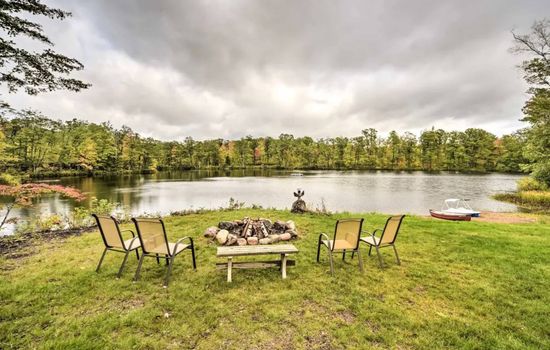The St. Croix River Visitor Center is open from mid-April to October, daily from 10:00 am to 5:00 pm, including federal holidays.
There is no entrance fee to visit the St. Croix National Scenic Riverway. Entry is free year-round.
From Minneapolis, take Highway 35E north to Highway 8, then east to the river’s edge, where wooded bluffs and historic towns await along a 200-mile scenic waterway.
Parking lots are available along the river, with limited spots in remote areas. Vehicles, including RVs and motorcycles, can park overnight in Riverway lots; no fees mentioned. Larger RVs can park at state parks like Interstate State Park.
Accessibility & permits
Emergency
- Cell service availability:Partial
Information not accurate?
Help us improve by making a suggestion.
In the heart of the American Midwest, the St. Croix National Scenic Riverway unfolds as a serene and vibrant tapestry of natural beauty. This federally protected river system, spanning 252 miles, is formed by the confluence of the St. Croix and Namekagon rivers, straddling the borders of Wisconsin and Minnesota. The landscape is a kaleidoscope of calm and rushing waters, shaded by forests and flanked by historic towns and wooded bluffs.
Here, one can canoe through the northwoods, where wolves, deer, and otters roam, or boat along the river to spot eagles, osprey, and kingfishers soaring overhead. The rivers are home to a diverse array of fish, including smallmouth bass, walleye, northern pike, and brook trout, making it a paradise for anglers. Campers can choose from numerous National Park Service-designated sites or state parks, while hikers can explore trails that transform into cross-country skiing paths in winter.
The riverway is steeped in history, with over 200 cultural sites including those of the Dakota, Ojibwe, and early European settlers. Seasonal festivals and events, such as summer concerts and ranger-led canoe tours, add a layer of community and engagement to the natural splendor. Nearby, artisan towns like St. Croix Falls and Hudson offer boutique shopping and dining experiences that complement the outdoors.
Local outfitters provide everything from canoe rentals to guided fishing trips, ensuring that visitors can fully immerse themselves in the riverway’s unique character. As the seasons change, the riverway transforms: spring brings blooming wildflowers and the songs of warblers, summer offers warm days perfect for swimming, autumn paints the forests in vibrant hues, and winter cloaks the landscape in a serene silence. This is a destination where nature, history, and community blend seamlessly, inviting travelers to experience the authentic charm of the St. Croix National Scenic Riverway.
- Area (mi²)
- 145
- Annual visitors
- 900 000
- Established year
- 1968
Top 3 Facts about St. Croix National Scenic Riverway
The Midcontinent Rift, which occurred about one billion years ago, is visible along the river, showcasing exposed igneous rock and sedimentary bedrock formed when the North American continent began to split apart.
In this verdant corridor, prairie, deciduous hardwood forest, and northern coniferous forest biomes converge, creating a diverse habitat for wildlife. Otters, deer, and porcupines roam the shores, while eagles, osprey, and kingfishers soar overhead. Native mussels and dragonflies thrive in the clean waters, home to bass, muskellunge, and walleye pike. Wooded bluffs shelter raccoons, foxes, and bears, and marshes are favored by wood ducks, mallards, and the great blue heron. This natural haven offers a serene backdrop for canoeing, fishing, and immersing oneself in the rich tapestry of flora and fauna.
In this pristine wilderness, crystal-clear waters flow through a forested landscape, highlighting the dramatic high bluffs and panoramic views of the valley. The river transitions from a cold-water to a warm-water ecosystem, supporting diverse flora and fauna, and features unique glacially formed landforms, including potholes and moraines created by the retreat of glaciers. The upper reaches boast a series of riffles and pools, bordered by hillsides of pine and oak, and low-lying marshes. Here, the scenic beauty is underscored by minimally developed landscapes and a primitive riverine environment.
Family programs
- Junior Ranger
- Ranger-led Tours
- Workshops & Hands-on Activities
- Scavenger Hunts
- Family Camping & Overnight
- Water-based Adventures
Travel Tips
Plan Ahead
Plan a 3-day summer visit to coincide with the full moon paddles. Arrive early, park near the visitor center, and prepare for muddy, rocky terrain. Pack meals and rest often, as options are limited. Wear sunglasses for strong UV reflection from the water.
Pack Appropriately
Pack layers for variable weather, quick-dry clothing, sturdy hiking shoes, and a waterproof jacket. Bring a daypack with essentials like a water bottle, headlamp, and binoculars. For longer stays, include a tent, sleeping bag, and water treatment supplies. Check the season for specific gear needs.
Respect Wildlife
Maintain a safe distance from wildlife, at least 100 yards from bears and wolves, and 25 yards from other animals. Avoid trails at dawn and dusk when wildlife is most active. Follow park rules and leave no trace to preserve the natural habitat. Dispose of trash properly and keep pets on leashes. Respect the environment to ensure a safe and enriching experience for both you and the wildlife.
Stay Informed
Stay informed about weather, fire restrictions, and park rules. Exercise caution on trails, near ledges, and around water. Follow signs and stay on marked paths. For emergencies, call park authorities at 911 or the park’s emergency number. Check park alerts regularly.
Seasons
In spring, enjoy mild temperatures (54°F high, 31°F low) and vibrant scenery. Attend the Earth Arts Spring Art Tour in May, or the Taste of the St. Croix Valley, perfect for outdoor enthusiasts and art lovers alike. Ideal for kayaking, hiking, and cycling.
Summer beckons with warm temperatures (70s-80s°F) and serene waters perfect for paddling, kayaking, and fishing. Enjoy the Taste of the St. Croix Valley in May, or hike the Ice Age National Scenic Trail under lush canopies. Ideal for outdoor enthusiasts, with mild weather and numerous trails to explore.
Experience autumn’s vibrant hues along 255 miles of scenic rivers, with temperatures ranging from 40°F to 60°F. Enjoy the Taste of the St. Croix Valley in October, savoring local flavors amidst crisp fall weather. Ideal for hiking, kayaking, and fishing, this season offers a serene and colorful getaway.
Experience winter’s serene beauty from December to March, with temperatures often below 32°F. Snow-covered trails invite cross-country skiing and snowshoeing, while frozen rivers offer ice fishing amidst breathtaking sunsets and wildlife sightings. A tranquil winter retreat for the adventurous.
Information not accurate?
Help us improve by making a suggestion.
Where to stay
Frequently Asked Questions
Ready to dive into what St. Croix National Scenic Riverway has to offer? Let’s tackle some of the burning questions you might have as you plan your visit!
-
Families enjoy canoeing, kayaking, tubing, swimming, fishing, and visiting historic towns like Taylors Falls.
-
Pets are welcome but must remain leashed (six feet max).
-
Yes, family-friendly campsites are available at William O’Brien State Park and Interstate State Park.
-
Fishing for walleye, bass, and muskie is excellent; Minnesota or Wisconsin licenses required.
-
Taylors Falls (Minnesota) and St. Croix Falls (Wisconsin) provide lodging, dining, and gear rentals.








